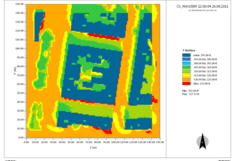Energy balance in urban regions
Urban heat island leads to higher air temperatures in the centre of cities compared to the surrounding rural areas. This temperature difference may comprise values up to 5 degrees and the heat island effect is expected to increase with the growing of the cities and with the expected climate change. One reason for the heat island effect is the thermal behaviour of sealed surfaces which is determined by its absorption coefficient, by its density, heat capacity and thermal conductivity. Urban energy balance models have been developed to quantify the energy fluxes and determine the surface and air temperatures in urban environments. A challenge representd the exact determination of the threedimensional radiation fluxes and of the three dimensional wind fields.

